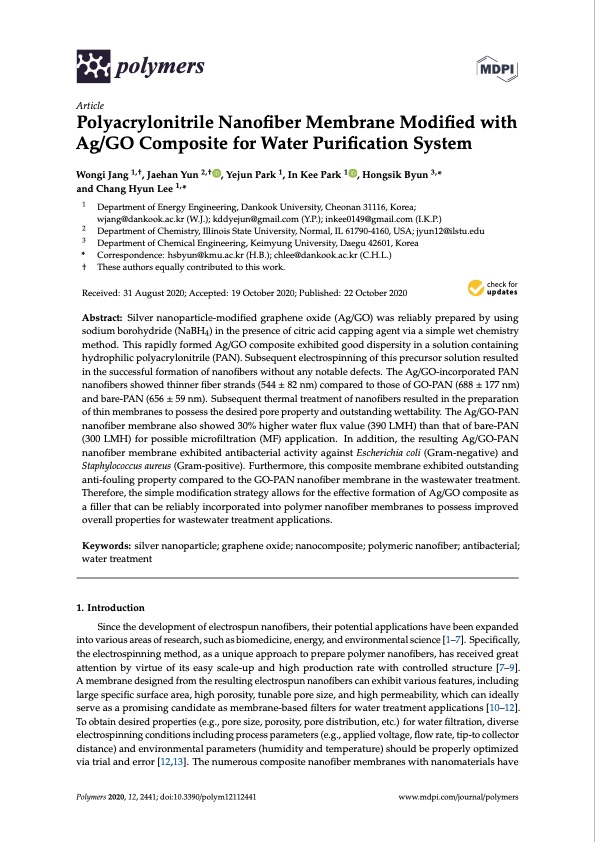
PDF Publication Title:
Text from PDF Page: 001
polymers Article Polyacrylonitrile Nanofiber Membrane Modified with Ag/GO Composite for Water Purification System Wongi Jang 1,†, Jaehan Yun 2,† , Yejun Park 1, In Kee Park 1 , Hongsik Byun 3,* and Chang Hyun Lee 1,* 1 2 3 * Correspondence: hsbyun@kmu.ac.kr (H.B.); chlee@dankook.ac.kr (C.H.L.) † These authors equally contributed to this work. Received: 31 August 2020; Accepted: 19 October 2020; Published: 22 October 2020 Department of Energy Engineering, Dankook University, Cheonan 31116, Korea; wjang@dankook.ac.kr (W.J.); kddyejun@gmail.com (Y.P.); inkee0149@gmail.com (I.K.P.) Department of Chemistry, Illinois State University, Normal, IL 61790-4160, USA; jyun12@ilstu.edu Department of Chemical Engineering, Keimyung University, Daegu 42601, Korea Abstract: Silver nanoparticle-modified graphene oxide (Ag/GO) was reliably prepared by using sodium borohydride (NaBH4) in the presence of citric acid capping agent via a simple wet chemistry method. This rapidly formed Ag/GO composite exhibited good dispersity in a solution containing hydrophilic polyacrylonitrile (PAN). Subsequent electrospinning of this precursor solution resulted in the successful formation of nanofibers without any notable defects. The Ag/GO-incorporated PAN nanofibers showed thinner fiber strands (544 ± 82 nm) compared to those of GO-PAN (688 ± 177 nm) and bare-PAN (656 ± 59 nm). Subsequent thermal treatment of nanofibers resulted in the preparation of thin membranes to possess the desired pore property and outstanding wettability. The Ag/GO-PAN nanofiber membrane also showed 30% higher water flux value (390 LMH) than that of bare-PAN (300 LMH) for possible microfiltration (MF) application. In addition, the resulting Ag/GO-PAN nanofiber membrane exhibited antibacterial activity against Escherichia coli (Gram-negative) and Staphylococcus aureus (Gram-positive). Furthermore, this composite membrane exhibited outstanding anti-fouling property compared to the GO-PAN nanofiber membrane in the wastewater treatment. Therefore, the simple modification strategy allows for the effective formation of Ag/GO composite as a filler that can be reliably incorporated into polymer nanofiber membranes to possess improved overall properties for wastewater treatment applications. Keywords: silver nanoparticle; graphene oxide; nanocomposite; polymeric nanofiber; antibacterial; water treatment 1. Introduction Since the development of electrospun nanofibers, their potential applications have been expanded into various areas of research, such as biomedicine, energy, and environmental science [1–7]. Specifically, the electrospinning method, as a unique approach to prepare polymer nanofibers, has received great attention by virtue of its easy scale-up and high production rate with controlled structure [7–9]. A membrane designed from the resulting electrospun nanofibers can exhibit various features, including large specific surface area, high porosity, tunable pore size, and high permeability, which can ideally serve as a promising candidate as membrane-based filters for water treatment applications [10–12]. To obtain desired properties (e.g., pore size, porosity, pore distribution, etc.) for water filtration, diverse electrospinning conditions including process parameters (e.g., applied voltage, flow rate, tip-to collector distance) and environmental parameters (humidity and temperature) should be properly optimized via trial and error [12,13]. The numerous composite nanofiber membranes with nanomaterials have Polymers 2020, 12, 2441; doi:10.3390/polym12112441 www.mdpi.com/journal/polymersPDF Image | Polyacrylonitrile Nanofiber Membrane Water Purification

PDF Search Title:
Polyacrylonitrile Nanofiber Membrane Water PurificationOriginal File Name Searched:
polymers-12-02441.pdfDIY PDF Search: Google It | Yahoo | Bing
Turbine and System Plans CAD CAM: Special for this month, any plans are $10,000 for complete Cad/Cam blueprints. License is for one build. Try before you buy a production license. More Info
Waste Heat Power Technology: Organic Rankine Cycle uses waste heat to make electricity, shaft horsepower and cooling. More Info
All Turbine and System Products: Infinity Turbine ORD systems, turbine generator sets, build plans and more to use your waste heat from 30C to 100C. More Info
CO2 Phase Change Demonstrator: CO2 goes supercritical at 30 C. This is a experimental platform which you can use to demonstrate phase change with low heat. Includes integration area for small CO2 turbine, static generator, and more. This can also be used for a GTL Gas to Liquids experimental platform. More Info
Introducing the Infinity Turbine Products Infinity Turbine develops and builds systems for making power from waste heat. It also is working on innovative strategies for storing, making, and deploying energy. More Info
Need Strategy? Use our Consulting and analyst services Infinity Turbine LLC is pleased to announce its consulting and analyst services. We have worked in the renewable energy industry as a researcher, developing sales and markets, along with may inventions and innovations. More Info
Made in USA with Global Energy Millennial Web Engine These pages were made with the Global Energy Web PDF Engine using Filemaker (Claris) software.
Infinity Turbine Developing Spinning Disc Reactor SDR or Spinning Disc Reactors reduce processing time for liquid production of Silver Nanoparticles.
| CONTACT TEL: 608-238-6001 Email: greg@infinityturbine.com | RSS | AMP |